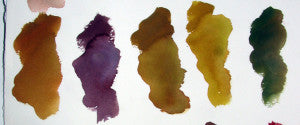 With the many inches of the rain we have had in the North Carolina mountains this year, something we have not been a stranger to is mud puddles. I have had my share of mud puddles in my driveway, in the front yard, in the backyard, in the garden, in the flower bed, and all around the house. Not very fun, at all, especially when you have to tiptoe and skip across the few rocks in the yard to avoid getting your feet wet! But sometimes playing in the mud can be fun! Remember when we used to enjoy playing in the mud, and making mud pies and getting all muddy? Well, while it was a very long time ago, it was still really fun! Even today, I still like playing in mud puddles! Now, I’m not going to tell you that I sit in a big mud puddle in my driveway and play in the mud. That’s not really the kind of mud puddle I am referring to. I am talking about watercolor mud puddles. The ones we all hate and try to avoid. When we mix too many different pigments together, when we use semi-opaque and opaque primaries together, or when we stir too much in an area of mixed color, what do we get? Mud!
With the many inches of the rain we have had in the North Carolina mountains this year, something we have not been a stranger to is mud puddles. I have had my share of mud puddles in my driveway, in the front yard, in the backyard, in the garden, in the flower bed, and all around the house. Not very fun, at all, especially when you have to tiptoe and skip across the few rocks in the yard to avoid getting your feet wet! But sometimes playing in the mud can be fun! Remember when we used to enjoy playing in the mud, and making mud pies and getting all muddy? Well, while it was a very long time ago, it was still really fun! Even today, I still like playing in mud puddles! Now, I’m not going to tell you that I sit in a big mud puddle in my driveway and play in the mud. That’s not really the kind of mud puddle I am referring to. I am talking about watercolor mud puddles. The ones we all hate and try to avoid. When we mix too many different pigments together, when we use semi-opaque and opaque primaries together, or when we stir too much in an area of mixed color, what do we get? Mud!
Our very own, Joe Miller, has some experience in this area. And he has a very useful tip to avoid making mud in your painting that is very well explained in this wonderful video! Joe mixes the colors on his paper and not on the palette. He scoops up the pigment with his very large flat brush and simply places the colors next to each other without much mixing once they are applied to the painting. The key to this technique is to NOT STIR the paints. Lay them in and leave them alone! Joe is using several American Journey transparent watercolor paints in his technique- Gamboge, Halloween Orange, Quinacridone Scarlet (Lucky Penny), Red Rose Deep (Rambling Rose), and Cobalt Blue, however, he does not use them all at the same time. Check it out! What a great tip!
Also, while thumbing through some of Joe’s workshop notes, I came across some really great information! Joe had written down Two and Three-Color mixes that he just loves! Why don’t you try out some of these great paint combinations?

Pat Weaver
Someone else I know likes to play in the mud. Well, again, not the same kind. Even still, Pat Weaver likes to mix puddles of mud and uses them to create beautiful neutral shades that are wonderfully useful in your paintings! Pat is an excellent watercolor artist and a master at mixing color. She visited Cheap Joe’s to teach a workshop earlier this year and took some time to share some simple watercolor tips with us.
Hey, did you know that Pat Weaver is a former Mayor and City Commissioner of Dade City? I just find that quite amazing. Another thing you might not know about Pat is that she can recite all of the colors of the color wheel, like really, really, fast, frontwards and backward! I was very impressed with her performance! Red, Red- Orange, Orange, Yellow- Orange, Yellow, Yellow-Green, Green, Blue-Green, Blue, Blue Violet, Violet, Red-Violet, and back to Red! And now backward…. Well, I am just going to have to practice a lot more before I will be able to recite them as fast as she can!
Pat shared many things about herself and her style of painting, but one of the most intriguing tips was about mixing neutral colors from the three primaries. In her book, “Watercolor Simplified”, she explains the term “tertiary color” as any two secondary colors mixed together to form a brown, gray, or earth tone. For example, when you mix orange and violet, you are really mixing yellow and red and blue and red or 1 part yellow, 1 part blue, and 2 parts red. This would give you a reddish brown color. Therefore, you are mixing the three primaries, which is basically mud, right?
In her demo, Pat used three transparent primary colors. She first, mixed equal amounts of each in a big puddle she called “mouse” gray. She made a swatch, then, she added more of one primary and then made another swatch and compared. Then, again and again, mixing even more of the primary and so on. You could actually do this forever and never make mud! Pat had an armful of colors on her palette, however, she rarely uses more than three colors at a time! This just goes on to show you really do only need three colors to complete a full-color painting. The only thing to remember is to use single pigment primaries that are transparent! If you follow this rule, you will rarely get the kind of mud you don’t want!

Pat’s Dog demo using the varying degrees of mud.
In this dog demo, Pat uses varying degrees of mud. Funny! He looks pretty clean, doesn’t he? (She may have just given him a bath!) The point here is, she is actually only using the three primaries! Here are some of her American Journey primary trios: Aureolin, Quinacridone Burnt Orange, Ultramarine Blue – MIXED
Quinacridone Gold, Quinacridone Burnt Orange, Ultramarine Blue – WARM Aureolin, Permanent Rose, Cobalt – COOL
To find out more information about Pat Weaver and her art visit www.patweaver.net.

I was so intrigued by this neat little trick that I just had to try it! Here is my rendition of her exercise of mixing neutral colors from the mud. I used American Journey Alizarin Crimson, Sour Lemon, and Cobalt Blue, all transparent pigments. First, I mixed a big puddle of equal amounts of the three primary colors, aka “Mud Puddle” or “Mother Mud”, then adjusted the mud puddle with one of the primaries. Painted a swatch, then either added more of the same color or another of the trio and painted another swatch. Here is what I ended up with. Pretty Neat, Huh? Now, You try it!

Warm Mixes by adding red and blue.

plus blue and yellow

adding red and blue to mud

Making common colors from mud!
Now, I have nothing against using a full palette of convenience colors in my studio palette. In fact, many of the three pigment variations of mixes you can achieve with this tip, only look similar to paints that usually have only one pigment. So, when it is convenient to have these single pigment paints available, it is better, because you will want to try to limit the number of different pigments in a mix to about three. This, in itself, reduces the chance of creating unwanted mud! The more pigments in a mix, the more chance you will end up with mud. Then you have plenty of color swatches available when needed.
However, a large number of paint tubes are not always convenient to travel with. It is great to know that you can extremely limit your palette to just three colors and have a vast array of colors to paint with. This is great for Travel Journaling, Plein Air painting, and traveling abroad with your materials! I, also, love the idea of mixing a big batch of “mother mud” as a permanent color in my limited palette. Then, it is just a matter of adjusting the mix to what you actually need!
So, the next time the skies “cloud-up” and you are stuck indoors because of rain, you can still play in the mud without getting wet and dirty! Try this exercise so you will be very familiar with mixing the variations of neutrals when you need them. And know, there is no need to throw away all of your lovely tubes of paint for this technique. Just be aware that when you need to travel light, you can, without sacrificing your love for lots of colors!
I hope you will try this little tip!
And a Special Thank You to Cheap Joe for his tips on how to Avoid making “mud” and Pat Weaver for her tips on how to Paint with “mud”!
Have a Happy “Mother Mud” Day! Or would that be Happy Mudder’s Day?
Anyway, Keep your Brushes Wet and “Muddy” whether it Rains or Not!







